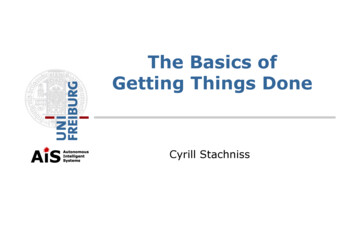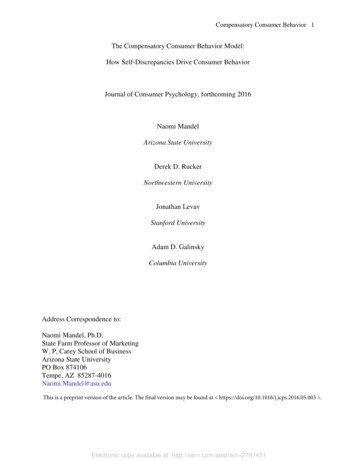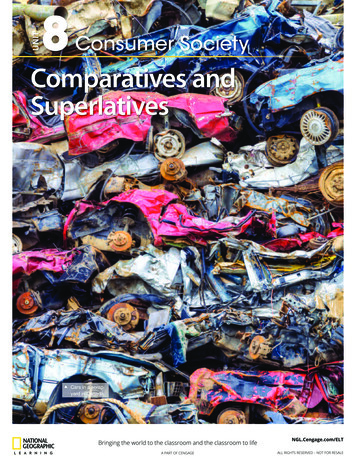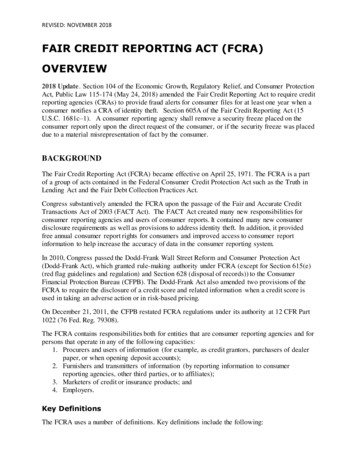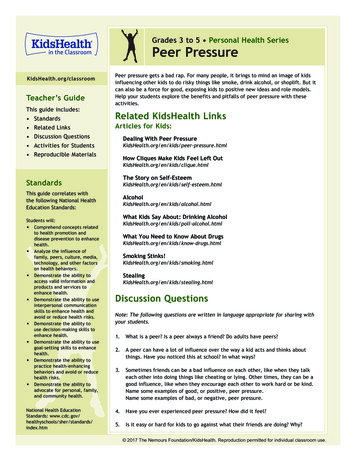
Transcription
A TEACHING & LEARNING RESOURCEConsumerStuff for Kidsconsumer.vic.gov.au
WriterPaul JohnsonLinnet Hunter - Education consultantAcknowledgementsConsumer Affairs Victoria (CAV) gratefully acknowledges the partnership withThe Office of Gaming and Racing (Victorian Department of Justice) in the development of this resource. the following teachers for trialling the units of work in their school:Illya Samarin, Glengala/Sunshine West Primary School, SunshineSusan M Wilson, Mount Waverley North Primary School, Mount WaverleyJohn Sandy, St Dominic’s Primary School, CamberwellMark MacGregor, Corpus Christi Primary School, GlenroyPamela Dudgeon, Abbotsford Primary School, AbbotsfordNatalie Will, Briar Hill Primary School, Briar HillAmanda Patton and staff, Ararat Primary School, AraratMelinda Atkinson, Keilor Heights Primary School, Keilor Heights the contribution made by Jennifer Quick, Curriculum Manager, Business Studies, Victorian Curriculumand Assessment Authority the contribution made by Mardi Hall, St Mary’s Primary School, Swan Hill to Unit 8: Is advertisingconsuming me?Community Support FundThis resource has been produced with the support of the Victorian Government throughthe Community Support FundPrinted by Ability Press, 25-27 Olive Gve, Keysborough VIC 3173Publication number C-02-1693ISBN 0-9750813-9-X
A teaching & learning resource S upports VELS Level 4Humanities – Economicsconsumer.vic.gov.aui
ContentsiiiivvviiIntroduction to Consumer Stuff for KidsKey TermsThe Victorian Essential Learning Standards (VELS)National Consumer and Financial Literacy Framework1147Unit 1 – I am a Consumer9917192124Unit 2 – An Informed Consumer27273033Unit 3 – Let’s Work353540454650Unit 4 – Money, Money, Money5353596164Unit 5 – What is an Economy?6767727575788386899294Activity 1 – Am I a Consumer?Activity 2 – Needs from WantsTake Home ActivityActivity 1 – Consumer Rights and WrongsActivity 2 – Make a ComplaintActivity 3 – Complaining in PersonActivity 4 – ScamsTake Home ActivityActivity 1 – Different People, Different JobsActivity 2 – Find Me a JobTake Home ActivityActivity 1 – Have an Interest in BankingActivity 2 – Different Ways to PayActivity 3 – Opportunity Cost or Opportunity Lost?Activity 4 – BudgetingTake Home ActivityActivity 1 – Scarce as Hen’s TeethActivity 2 – What is a Resource?Activity 3 – Using ResourcesTake Home ActivityUnit 6 – Consuming Planet EarthActivity 1 – What a Waste!Take Home ActivityUnit 7 – It's Your ChoiceActivity 1 – Learning from MistakesActivity 2 – Stay ConnectedActivity 3 – Think SMARTActivity 4 – Be RealActivity 5 – Have a GoActivity 6 – Value YourselfTake Home ActivityInquiry Unitsii95101Unit 8 – How Can We Make Money?103109Unit 9 – Is Advertising Consuming Me?Take Home ActivityTake Home Activity
Introduction to Consumer Stuff for KidsBefore you start.This revised edition of Consumers Stuff for Kids contains a number of exciting new features. The new unit,Its Your Choice, highlights the need to improve student resilience and feelings of self-worth. Poor decisionmaking in areas such as consumer purchases and inappropriate social behaviour can be linked to feelings oflow self-esteem and over dependence on peer actions.The accompanying DVD, Clips for Kids complements the message throughout this publication and especiallyin the unit, Its Your Choice! It provides a most engaging format for student learning. Wacky and his friends willcertainly be popular characters upon which to stimulate student discussion and direct student learning.The Take Home activity added to each unit will foster a genuine partnership between home and school learning. Parents/carers and their children will be able reinforce school learning with real life consumer relatedactivities at home.Tracking Student ProgressThe red arrow symbol in each activity represents a suggested opportunity for the student to demonstrate theirknowledge and understanding of key concepts. Teachers are encouraged to use these activities to track studentprogress towards the VELS Level 4 Humanities – Economics and Level 4 Personal Learning Domain standards.For example:ÎÎStudents create a checklist of the most effective ways to deal with returning a product.The list might include: acting quickly discussing the problem in person calmly stating the problem being aware of your consumer rights keeping the receipt.See page v and vi to provide a context for the standards.iii
Key TermsAudit: Audit means checking a budget carefully to makesure the income, expenditure and balance are calculated correctly.Barter: Exchanging goods or services for other goods orservices.Budget: A plan for saving, spending and managingmoney. It has two parts: income and expenditure.Capital Resources: Goods made by people whichare used to make other goods or to provide services.A hammer is a capital resource.Cash: Money in the form of notes and coins.Consumer: Consumers are users of goods and services.Each one of us is a consumer.Consumer Affairs Victoria (CAV): Victoria’s leadconsumer protection agency. CAV helps Victorians dealwith consumer issues. Visit www.consumer.vic.gov.au orcall 1300 55 81 81.Credit Cards: A plastic card issued by banks or otherfinance companies. Consumers use a credit card to buysthings without using cash. At the end of the month theconsumer receives a bill to repay the total amount theyhave spent.Demand: How much consumers want a particular goodor service.Deposit: When a consumer leaves (or deposits) someof their money in a bank it is called a deposit.EFTPOS: Electronic Funds Transfer at Point of Sale.This means money (funds) from your bank accountmoves (transfers) to the shopkeeper’s bank accountelectronically.Natural Resource: Resources which come from thenatural environment like water, gold, land and timber.Needs: Goods and services which consumers need tosurvive. These include fresh water, clothing and food.Opportunity Cost: This term describes what happenswhen consumers have limited money but unlimitedchoice. When you make a choice you give up anopportunity to buy something else with that money.Personal Identification Number (PIN): A secret (usually4 digit) code used by consumers when using their cardat an ATM or EFTPOS facility.Production: The actual making of goods or providingof services.Receipt: A receipt is your proof of purchase and is animportant record of where and when you bought something. You need a receipt if something goes wrong andyou want a refund.Redress: Redress means the right to be compensatedfor faulty goods or unsatisfactory services.Scams: Scams are tricks or “cons” to take your moneyand rip you off. Scams are illegal and unethical.Scarcity: Scarcity is the problem of limited resourcesavailable to satisfy unlimited wants.Services: Services are things done for consumers. Thisincludes bike repairs, receiving a hair-cut or your housebeing supplied with electricity.Expenditure: Money going out from your budget.This is money which is being spent.Supply: How available a good or service is forconsumers.Export: Goods sent from one country to anothercountry. For example, Australia exports wheat to othercountries.Sustainable consumption: Consumer decisions madetoday have a big impact on the environment now and inthe future. Sustainable consumption means consumersconsider the environment and consume responsibly.Goods: Items bought by consumers you can actuallytouch. Examples of goods include food, toys andclothing.Human Resources: The people who do the work, alsocalled labour.Import: Goods received in one country from anothercountry. For example, Australia imports computersfrom other countries.Income: Money coming into your budget. This may befrom money earned from working.ivInterest: There are two types of interest.1. Interest is the money a consumer earns from the bankfor depositing (leaving) their money in the bank.2. Interest is the money consumers are charged bythe bank for borrowing money from the bank.Voluntary Work: Work undertaken by people withoutreceiving payment.Wants: Goods or services which consumers can livewithout but would like to have.Withdrawal: Taking money from your bank account.
Victorian Essential Learning Standards (VELS)The following units are based on Level 4 Humanities - Economics and Level 4 Personal Learning Domain.However there are many opportunities to integrate other Domains. Teachers are encouraged to extend theactivities to fully address the needs and abilities of their students and to further integrate relevant Domains.The material below is an extract from material produced by the Victorian Curriculum and AssessmentAuthority, Australia. Students and teachers should consult the Victorian Essential Learning Standardswebsite for more information. This material is copyright and cannot be reproduced in any form withoutthe written permission of the VCAA.For more information visit http://vels.vcaa.vic.edu.au.Level 4 Humanities – EconomicsLearning focusAs students work towards the achievement of Level 4 standards in Economics, they learn about the nature ofthe economic problem (scarcity): that is, that our needs and wants are unlimited but the resources availableto satisfy these wants are limited. They explore how the community defines, classifies and uses resources.They learn about the processes of consumption, production and distribution in meeting needs and wants, andthe role of consumers, workers and producers in the economy. They consider factors affecting their spendingand why it is important to be an informed consumer when making spending decisions. They investigate theimportance of personal money management and the role of banking, budgeting and saving.Students consider the nature and meaning of work and its relationship to other activities in people’s lives,including leisure. They examine various types of work and enterprise in a range of settings, including home,school and the community, and identify the different natures of paid and unpaid work. Students use the inquiryprocess to plan investigations about economic issues in the home (for example, which mobile phone or pairof runners to buy), school (for example, which bus company to hire for an excursion) or local community (forexample, whether a small factory or residential townhouses should be built on a vacant lot next to the school)and form conclusions supported by evidence.Students practise contesting ideas, debating and using evidence to form and express opinions on economicissues that interest and/or have an impact on themselves and on society, particularly their local community.They expand their economic vocabulary to include such terms as consumption, production, distribution,enterprise and identify, and learn to collect and process data from a range of sources, including electronic media.StandardsEconomic knowledge and understandingAt Level 4, students describe the nature of the economic problem (scarcity) and explain how selected goodsand services are produced and distributed. Students describe the difference between needs and wants, andtheir own roles as producers and consumers of goods and services. They explain the need to be an informedconsumer. They explain the role of work in society and distinguish between paid and unpaid work. Theycompare different types of work and enterprise in the local community. Students demonstrate a basicunderstanding of personal money management and the role of banking, budgeting and saving.Economic reasoning and interpretationAt Level 4, students use the inquiry process to plan economics investigations about economic issues in thehome, school or local community and form conclusions supported by evidence.v
Victorian Essential Learning Standards (VELS)Level 4 Personal LearningLearning focusAs students work towards the achievement of Level 4 standards in Personal Learning, they explore individualstrategies and skills that assist in their learning, such as the use of T charts to develop effective listening skillsand concept webs to link ideas. With support, they consider a range of approaches to learning and reflect onhow the approaches they use influence the quality of their learning. They explore learning styles which maynot be their preferred style and consider why such experimentation is an important aspect of their learning.Students seek and use teacher feedback to develop their content knowledge and understanding and reflecton how their prior knowledge has changed. They explore how personal values, perspectives and attitudescontribute to the development of content knowledge and understanding.In selected reflective activities, students explore the impact of various emotions on their learning and theylearn to maintain a positive attitude. They consider the impact of impulsive behaviour in themselves andothers on their learning and implement strategies for managing their own impulsive behaviour; for example,ensuring they understand directions fully, and developing a plan or strategy for addressing issues that arise.They discuss the value of persistence and effort, and reflect on how these qualities affect their learning. Asa class or in groups, students recognise their responsibilities for managing their learning, such as stayingfocused and on task.Through participation in a variety of group and whole-class activities, students begin to articulate theadvantages of learning effectively with, and from, their peers. They seek feedback from peers and considerthe validity of the feedback they receive. They identify the values that underpin the creation of a classroomenvironment that will support the learning of all students such as respect, equity and inclusion.Students develop, justify and monitor their own learning goals. They learn to apply strategies for managingthe completion of both short and extended tasks within timeframes set by the teacher and they reflect on howeffectively they were able to use these strategies. They are provided with opportunities to manage and monitorprogress of some tasks independently, and they compare how they undertake independent tasks and teacherdirected tasks. They review their work for accuracy before presenting it for assessment.StandardsThe individual learnerAt Level 4, students identify, with support, their preferred learning styles and use strategies that promotelearning. They monitor and describe progress in their learning and demonstrate learning habits that addresstheir individual needs. They seek and respond to teacher feedback to develop their content knowledge andunderstanding. They identify and explain how different perspectives and attitudes can affect learning. Theynegotiate learning improvement goals and justify the choices they make about their own learning. Studentsactively develop, monitor and refine protocols that create a positive learning environment in the classroom.Managing personal learningAt Level 4, students develop and implement plans to complete short-term and long-term tasks withintimeframes set by the teacher, utilising appropriate resources. They undertake some set tasks independently,identifying stages for completion. They describe task progress and achievements, suggesting how outcomesmay have been improved. They persist when experiencing difficulty with learning tasks. They seek and uselearning support when needed from peers, teachers and other adults. They practise positive self talk. Theydemonstrate a positive attitude to learning within and outside the classroom.vi
National Consumer and Financial Literacy FrameworkThe National Consumer and Financial Literacy Framework (the Framework) was developed in 2005 for theMinisterial Council on Education, Employment, Training and Youth Affairs (MCEETYA), by the MCEETYAConsumer and Financial Literacy Working Party. This multi-disciplinary framework relates to the employabilityskills and will assist in achieving national consistency in curriculum and resources to support that curriculumfor teachers of consumer and financial literacy. The VELS Economics Domain has close links to the Framework.The Framework has four dimensions of consumer and financial literacy. These dimensions are interrelated andembrace the knowledge, skills, understandings and values related to key concepts.The dimension of: Knowledge and understanding is about the nature and forms of money, how it is used and theconsequences of consumer decisions Competence is the application of consumer and financial knowledge and skills in a range ofchanging contexts Enterprise is the opportunity to use initiative, build financial capabilities and manage risk-takingwhen making consumer and financial decisions Responsibility is appropriate consumer and financial decisions that display care for self, others,the community and the environment.For more information on the Framework visit the website: www.mceetya.edu.au/mceetya/national financialliteracy framework homepage,14429.html. Alternatively, visit the Australian Government's UnderstandingMoney website at ungpeople/professionaldevelopment.aspx for information to support financial literacy programs in primary and secondary schools.Below are the Descriptions of Learning for Year 5. Each outcome has been coded (KU 1, KU 2 etc). Thesecodes are referred to at the beginning of each unit of this resource to show how the student activities link tothe Framework. There are also Description of Learning for year 3, 7 and 9 in the Framework.Year 5Students are aware of a range of forms of money and can discuss their rights and responsibilities in everydaytransactions. Students understand that money can also be borrowed through credit and be provided bygovernment payments.Students know about the different ways money can be kept and the importance of saving. They recognise thatfamily income may be limited and begin to understand that matching household expenditure against incomeis important when considering family finances. They understand broad issues of quality of life, total familyincome, expenditure and savings.They realise advertising and peer pressure can affect choice and are aware of the social and environmentalconsequences of their choices.Knowledge and UnderstandingStudents:KU 1Understand that buyers have rights and responsibilities.For example, understand that people have a right to receive goods that meet health and safetystandards, and that people have a responsibility to pay on time and repay borrowings (credit).vii
National Consumer and Financial Literacy FrameworkKU 2Understand there are different forms of income.For example, understand that wages/salaries, government payments, and interest on savingsare all forms of income.KU 3Understand that money can be borrowed.For example, a credit card, a personal loan and a mortgage are ways of borrowing money.KU 4Understand that savings can earn interest.For example, know that they can earn interest by putting money in a savings account.CompetenceStudents:C1Classify and compare goods and services.For example, classify and compare goods and services by reviewing product labelling, and healthand safety warnings.C2Prepare simple plans and examine financial records.For example, prepare a simple budget for a fundraising activity, and identify GST on receipts andsales dockets.C3Accurately complete simple financial forms.For example, complete forms such as bank deposit slips, registrations for a sport, leisure orrecreational activity.EnterpriseStudents:E1Use initiative and explore opportunities that can or may contribute to income.For example, develop a simple plan for a class fundraising event or enterprise, and design basiccriteria to evaluate success.E2Initiate support for school fundraiser from community groups and businesses.For example, initiate support such as sponsorship, inkind support and promotional materials.ResponsibilityStudents:R1Value savings.For example, store and build wealth to meet current and future needs.R2Care about the impact of their consumer and financial decisions on themselves, others, communityand the environment.For example, identify how responsible attitudes to issues such as recycling and water conservationcan benefit the family, the community and the environment.R3Explore the values associated with participating in an enterprise.For example, consider issues related to trust and obligation when purchasing and supplying goodsand services.
IamaConsumer1UnitConsumer and FinancialLiteracy FrameworkVELS Humanities - EconomicsThe key elements of the Economics knowledge andunderstanding standard addressed by this unit are:This unit addresses the"Students describe the difference betweenfollowing outcome:needs and wants and their own roles asSee page viii forconsumers of goods and services".more information.Refer to the Level 4 Humanities - Economics Domain LearningFocus statement on page vii to provide a context for the standards. C1ACTIVITY 1 – Am I a Consumer?Learning ObjectivesKey Terms Students identify themselves as consumers. Students differentiate between goods and services. consumers goods servicesLesson DurationPreparation»»50 minutes»»butcher's paperTeacher NotesConsumers are users of goods and services. Each one of us is a consumer. Students mayincorrectly assume that 'to consume' means to eat. It is important for students to broaden theirunderstanding of 'consuming' to include any goods or services they use in their lives. Consumersfrequently consume electrical goods, transport services, clothing, educational services, food anddrink.IntroductionAsk the students to use the 3 step definition strategy to define words such as consumer, goods and services.WordconsumerWhat I think itmeansWhat the dictionarysays it meansHow it might be usedin this contextsomeone who is acustomer1. a person who purchasessomeone who goesto shops and . . .goods and services . . .Alternatively, ask the students:“What do you think a consumer is?”Students write down what they think a consumer is.“Stand up if you think you are a consumer.”Ask students to justify their answer by writing down briefly why they think they are or are not a consumer.“Put one hand on your head if you think I (the teacher) am a consumer.”Ask students to justify their answer.CONSUMER AFFAIRS VICTORIANEED CONSUMER HELP? 1300 55 81 81www.consumer.vic.gov.au1
Task - Consumer BrainstormIn groups, ask students: “Brainstorm everything you have consumed today. This means, what things have you needed/used/eatentoday from the moment you woke up to right now?”Students could record their thoughts on butcher's paper, in a table, etc.Technology- for example,Clothing- pyjamas, footwear, socks,woke up to an alarm clock,listened to the radio/televisionduring breakfast, used the toaster etc.underwear, hat, clothes worn at school.How have I been a consumer today?Transport- car, school bus,Food- what has been eaten bybicycle, train.At School-pens, pencils, books,balls, desks, computers.the group today?List all the food and beveragesconsumed by the group.During the Consumer Brainstorm introduce the concept “Consumers use either goods or services.”Goods are items you can actuallytouch and include things like clothing,food or toys.Services include bike repairs, receiving a hair-cut oryour house being supplied by electricity. These areservices provided to consumers by others.This new information may further extend the potential of the brainstorm.After the Consumer Brainstorm direct students:ÎΓUsing your consumer brainstorm, highlight all the GOODS in one colour and theSERVICES in another colour.”Task - Venn DiagramStudents individually create a Venn Diagram, based on the information from their brainstorm.One circle on the Venn Diagram contains GOODS and the other SERVICES. Some items may be botha good and a service. For example, delivered food is both a good and service - therefore it would beincluded in the intersecting area of the diagram.Students list at least 10 goods and 10 services to add to their Venn Diagram.ÎÎTo track progress, provide students with the following examples of goods and services.Students position each within their Venn Diagram.Examples: Going to the dentist (S) Buying a mobile phone and network coverage (Both) Taking the cat to the vet (S) Buying the cat kitty litter (G) A new TV which is fully set-up and installed (Both)2CONSUMER AFFAIRS VICTORIA Hiring a DVD (Both) The Victorian Police (S) Buying a T-shirt (G) Buying a pair of shoes (G) Home delivered pizza (Both) Using a tram (S)NEED CONSUMER HELP? 1300 55 81 81GOODSBOTHSERVICESwww.consumer.vic.gov.au
ConclusionPlay “The Goods ‘n Services Game”Teacher or nominated student has a collection of completed Venn Diagrams in front of them.Students choose one of three options: Goods, Services or Both and commit in writing.The teacher or nominated student then calls out one of the student entries from the collectionof completed Venn Diagrams. For example “Buying a netball”.All the students who selected “good” remain in the game because buying a netball is a “good”.Those who selected “both” or “service” are eliminated.Students then reselect one of three options: Goods, Services or Both and commit in writing.The teacher or nominated student then calls out one of the student entries from the collectionof completed Venn Diagrams. For example, “Getting broadband internet service at home”.All the students who selected “Service” remain in the game because broadband internet serviceis a “service”. Those who selected “Both” or “Good” are eliminated.The final student remaining is the Goods ‘n Services Game winner.Early Finisher/Extension/Consolidation TaskEncourage students to look at the advertisements in their local newspaper or local Yellow Pagesand identify:Providers of goods and services in their local community - examples may include stores,supermarkets, trades people, individuals in private business (dentists, hairdressers, builders), thegovernment (hospitals, education, transport, social security, welfare agencies).The proportion of advertisements for goods compared to advertisements for services.CONSUMER AFFAIRS VICTORIANEED CONSUMER HELP? 1300 55 81 81www.consumer.vic.gov.au3
ACTIVITY 2 – Needs from WantsLearning ObjectivesKey Terms Students will learn to distinguish between needs and wants. needs Students will demonstrate how needs and wants aredifferent for different people. wantsLesson DurationPreparation» 60 minutes» copy What does my country need? activity sheetTeacher NotesNeeds - things we cannot live without.Wants - things that we can live without, but like to have.What determines our needs and wants?We have different wants and needs because of factors including age, health, occupation,environment, location, culture and beliefs. Our needs and wants can change.For example, our needs and wants will change if we:get oldermove to a new country/town/suburblive with a different group of peoplego to a different schoolget a different joblose our jobget sickIntroduction1. Students use the 3 step definition strategy to define a need and a want.Have students share their definitions with peers.2. Students then have a chance to test their definition of a need and a want. Use an imaginary line in theclass and label one end Strongly Agree and the other end Strongly Disagree. Students respond to eachstatement below by positioning themselves along the agree/disagree line. Give students an opportunityto justify their decision.Statements:"Chocolate is a need.""A new computer is a need.""Friendship is a need.""Sleep is a need.""Clothes are a want.""Clean water is a want.""A holiday to Fiji is a need."After, students review their definitions of needs and wants.ÎÎStudents should write down their new definition of needs and wants, or justify why their firstdefinition did not need to be altered.Task - Group workIn the next two tasks, students work in cooperative groups of 2 or 3.Group Task OneAsk each group to identify three needs and three wants of one of the people in the list on thefollowing page.4CONSUMER AFFAIRS VICTORIANEED CONSUMER HELP? 1300 55 81 81www.consumer.vic.gov.au
Group123456789101112Person(list 3 NEEDS and 3 WANTS)A rock starA babyA person in a wheelchairA computer salespersonA non-English-speaking family arriving in AustraliaAn athlete preparing for the OlympicsA parent of an 11 year oldA family whose house has been destroyed by fireA computer game designerA person climbing Mount EverestAn astronautA dairy farmerGroup Task TwoDistribute one copy of What does my country need? activity sheet to each group.Each group should work independently, follow the instructions and answer each question.Post Task DiscussionAsk students:"Which items were most commonly eliminated in the first round? Why?""Which items were most commonly eliminated in the second round? Why?""Did the members of your group have any disagreements over the items to eliminate?""Which ones and why?""What do you think is the difference between “needs” and “wants”?""Which items on the list were needs? Which were wants?""Do needs and wants differ for different people?""Are some people’s opinions and decisions right or wrong?"ConclusionUsing a T Chart small groups use the two columns and list opposing facts and features of needs and wants.(see page 72 for a sample T Chart)ÎÎAfter a whole class discussion and T chart activity, students individually prepareÎÎanswers to the questions discussed above and justify their answers when required.CONSUMER AFFAIRS VICTORIANEED CONSUMER HELP? 1300 55 81 81www.consumer.vic.gov.au5
What does my country need?NEEDSthings we cannotlive withoutWANTS things that we can livewithout but like to have.NAME . . . . . . . . . . . . . . .Imagine you are the Prime Minister of a new country. You and the other leaders in the new countrywant to provide all young people in the country with the basic things that they need and want.The list below includes the needs and wants the leaders have drawn up.As a grou
Receipt: A receipt is your proof of purchase and is an important record of where and when you bought some-thing. You need a receipt if something goes wrong and you want a refund. Redress: Redress means the right to be compensated for faulty goods or unsatisfactory services. Scams: Scams are tricks or "cons" to take your money and rip you off.
